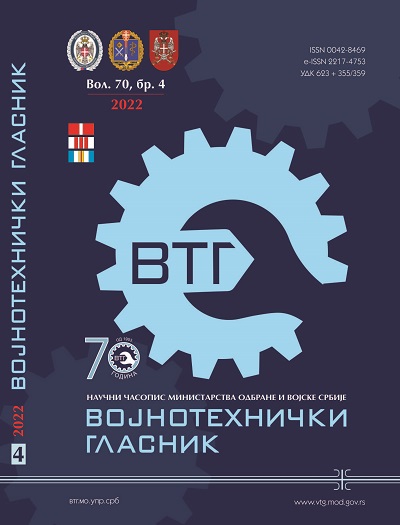Numerička analiza frontalnog udara projektila 12,7 mm u pancirnu ploču
Sažetak
Introduction/purpose: The paper presents a numerical simulation of an impact of a 12.7 mm projectile on an armored metal plate with a velocity of 500 m/s at a distance of 900 m. Numerical simulations offer the possibility of drastically reducing the time required to obtain results in comparison to the time required for planning, organization and execution of experiments. The numerical simulation is done by variations in the thickness of the armor metal plate, specifically an armor metal plate of a thickness of 10 mm, 17 mm, 18 mm, and 23 mm. The mentioned armored plate thicknesses were chosen based on the results in order to determine the limit thickness of the armored plate for the projectile perforation limit, as well as for complete ballistic protection.
Methods: Finite element modeling is used for analyzing stresses and deformations of the armored plates. The mentioned method calculates the impact of the projectile on the obstacle, precisely the collision of the projectile and the armor plate.
Results: For the comparative analysis, the parameters used are the values of the stress and the displacement. For each of the above-mentioned thicknesses of the armored metal plate, the values of stress and displacement during projectile impact were determined. The results of this study show how the thickness of the armor plate affects the interaction of the projectile and the armor plate.
Conclusion: If the physical and chemical characteristics of the armored plate remain unchanged, as the thickness of the armored plate increases, the possibility of projectile penetration decreases, and vice versa. This research is of essential importance because it analyzes the stresses and deformation of armor plates whose basic role is the protection of personnel and equipment from the projectile impact. In this regard, the thickness of the armored plate for semi-penetration of the projectile is determined.
Reference
Feng, J., Sun, W., Wang, L., Chen, L., Xue, S. & Li, W. 2020. Terminal ballistic and static impactive loading on thick concrete target. Construction and Building Materials, 251, art.number:118899. Available at: https://doi.org/10.1016/j.conbuildmat.2020.118899>
Jena, D.P., Jena, D.K. & Kumar, S. 2019. Simulation of Bullet Penetration using Finite Element Method. In: 2019 International Conference on Range Technology (ICORT), pp.1-4. Available at: https://doi.org/10.1109/ICORT46471.2019.9069609>
-Livermore Software Technology. 2014. LS-DYNA, method: Explicit dynamic analysis, LS-PrePost-4.5-A New Post Processor for Use LSDYNA. Livermore, CA, USA: Livermore Software Technology.
Mahfuz, H., Zhu, Y., Haque, A., Abutalib, A., Vaidya, U., Jeelani, S., Gama, B., Gillespie, J. & Fink, B. 1999. Investigation of high-velocity impact on integral armorusing finite element method. International Journal of Impact Engineering, 24(2), pp.203-217. Available at: https://doi.org/10.1016/S0734-743X(99)00047-0>
Meng, S., Taddei, L., Lebaal, N. & Roth, S. 2021. Advances in ballistic penetrating impact simulations on thin structures using Smooth Particles Hydrodynamics: A state of the art. Thin-Walled Structures, 159, art.number:107206. Available at: https://doi.org/10.1016/j.tws.2020.107206>
Rajole, S., Ravishankar, K.S. & Kulkarni, S.M. 2020. Performance study of jute-epoxy composites/sandwiches under normal ballistic impact. Defence Technology, 16(4), pp.947-955. Available at: https://doi.org/10.1016/j.dt.2019.11.011>
Wang X. & Shi, J. 2013. Validation of Johnson-Cook plasticity and damage model using impact experiment. International Journal of Impact Engineering, 60, pp.67-75. Available at: https://doi.org/10.1016/j.ijimpeng.2013.04.010>
Sva prava zadržana (c) 2022 Miloš S. Pešić, Aleksandra B. Živković, Aleksa D. Aničić, Lazar J. Blagojević, Petko M. Bonchev, Predrag R. Pantović

Ovaj rad je pod Creative Commons Autorstvo 4.0 međunarodnom licencom.
Vojnotehnički glasnik omogućava otvoreni pristup i, u skladu sa preporukom CEON-a, primenjuje Creative Commons odredbe o autorskim pravima:
Autori koji objavljuju u Vojnotehničkom glasniku pristaju na sledeće uslove:
- Autori zadržavaju autorska prava i pružaju časopisu pravo prvog objavljivanja rada i licenciraju ga Creative Commons licencom koja omogućava drugima da dele rad uz uslov navođenja autorstva i izvornog objavljivanja u ovom časopisu.
- Autori mogu izraditi zasebne, ugovorne aranžmane za neekskluzivnu distribuciju rada objavljenog u časopisu (npr. postavljanje u institucionalni repozitorijum ili objavljivanje u knjizi), uz navođenje da je rad izvorno objavljen u ovom časopisu.
- Autorima je dozvoljeno i podstiču se da postave objavljeni rad onlajn (npr. u institucionalnom repozitorijumu ili na svojim internet stranicama) pre i tokom postupka prijave priloga, s obzirom da takav postupak može voditi produktivnoj razmeni ideja i ranijoj i većoj citiranosti objavljenog rada (up. Efekat otvorenog pristupa).

